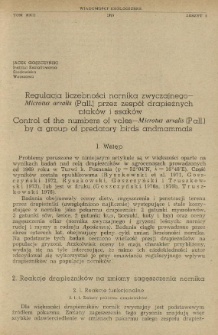- Search in all Repository
- Literature and maps
- Archeology
- Mills database
- Natural sciences
Advanced search
Advanced search
Advanced search
Advanced search
Advanced search

Object
Title: Regulacja liczebności nornika zwyczajnego - Microtus arvalis (Pall.) przez zespół drapieżnych ptaków i ssaków
Subtitle:
Control of the numbers of voles - Microtus arvalis (Pall.) by a group of predatory birds andmammals ; Control of the numbers of voles - Microtus arvalis (Pall.) by a group of predatory birds and mammals
Contributor:
Polska Akademia Nauk. Komitet Ekologii
Publisher:
Place of publishing:
Description:
Pages 255-264 ; 24 cm ; Bibliographical references (pages 263-264) ; Abstract in English
Type of object:
Abstract:
The article is based on studies either already published or prepared for printing on the relations between predatory birds and mammals and the common vole. The functional reactions of predators to variations in density of voles are discussed (Fig. 1). The group of species highly specialized in catching this vole and the group of species with diets of a polyphagous character have been distinguished within the community of predators examined. It is emphasised that penetration for hunting purposes of different crops is conditioned by the vole’s density (Tab. I). Numerical increase in predators depends on the biology of the species and may be the effect of migration (to a considerable distance in the case of buzzards or short expeditions in the case of cats) or natality (Fig. 2).Using estimates of the extent of pressure by predators on vole populations as a basis, the author states that the predatory birds and mammals examined are not capable of counteracting mass irruptions of the vole neither are they responsible for reducing such mass irruption (see Fig. 3). Mass appearance of the vole coincides with the period of particularly luxuriant development of vegetation, which makes it far more difficult for the predators to catch the rodents. Therefore despite the lack of accuracy in estimates of pressure it would appear that the controlling role of predators cannot be considered as equivalent to the possibility of counteracting mass appearances of the vole. It may be that the high degree of pressure by predators on voles when densities are low increases the length of the cycle and reduces the threshold numbers of the future irruption. Further studies are necessary to solve this problem. It is suggested that the mosaic character of the area should be intensified (e.g. alternating crops preferred by voles with cultivated fields of root crops) which wTould make contact between voles more difficult and facilitate their capture by predators. Emphasis has also been laid on the question of unjustified shooting by hunters and gamekeepers of certain predators (e.g. cats).
Relation:
Volume:
Issue:
Start page:
End page:
Detailed Resource Type:
Resource Identifier:
oai:rcin.org.pl:153814 ; ISSN 0013-2969
Source:
MiIZ PAN, call no. P.3259 ; click here to follow the link
Language:
Language of abstract:
Rights:
Creative Commons Attribution BY 3.0 PL license
Terms of use:
Copyright-protected material. [CC BY 3.0 PL] May be used within the scope specified in Creative Commons Attribution BY 3.0 PL license, full text available at: ; -
Digitizing institution:
Museum and Institute of Zoology of the Polish Academy of Sciences
Original in:
Library of the Museum and Institute of Zoology of the Polish Academy of Sciences
Projects co-financed by:
Access:
Object collections:
- Digital Repository of Scientific Institutes > Partners' collections > Museum and Institute of Zoology PAS > Scientific Journals
- Digital Repository of Scientific Institutes > Literature > Journals/Articles
Last modified:
Feb 4, 2025
In our library since:
Dec 29, 2020
Number of object content downloads / hits:
201
All available object's versions:
https://rcin.org.pl./publication/107859
Show description in RDF format:
Show description in RDFa format:
Show description in OAI-PMH format:
Objects Similar
Babińska-Werka, Joanna
Dehnel, August Gustaw (1903–1962)
Łuczak, Jadwiga Tarwid, Kazimierz
Adamczewska-Andrzejewska, K. A. Mackin-Rogalska, R. Mystkowska, E. T. Nabagło, L.
Goszczyński, Jacek
Fedyk, A. Ruprecht, A. L.

 INSTYTUT ARCHEOLOGII I ETNOLOGII POLSKIEJ AKADEMII NAUK
INSTYTUT ARCHEOLOGII I ETNOLOGII POLSKIEJ AKADEMII NAUK
 INSTYTUT BADAŃ LITERACKICH POLSKIEJ AKADEMII NAUK
INSTYTUT BADAŃ LITERACKICH POLSKIEJ AKADEMII NAUK
 INSTYTUT BADAWCZY LEŚNICTWA
INSTYTUT BADAWCZY LEŚNICTWA
 INSTYTUT BIOLOGII DOŚWIADCZALNEJ IM. MARCELEGO NENCKIEGO POLSKIEJ AKADEMII NAUK
INSTYTUT BIOLOGII DOŚWIADCZALNEJ IM. MARCELEGO NENCKIEGO POLSKIEJ AKADEMII NAUK
 INSTYTUT BIOLOGII SSAKÓW POLSKIEJ AKADEMII NAUK
INSTYTUT BIOLOGII SSAKÓW POLSKIEJ AKADEMII NAUK
 INSTYTUT CHEMII FIZYCZNEJ PAN
INSTYTUT CHEMII FIZYCZNEJ PAN
 INSTYTUT CHEMII ORGANICZNEJ PAN
INSTYTUT CHEMII ORGANICZNEJ PAN
 INSTYTUT FILOZOFII I SOCJOLOGII PAN
INSTYTUT FILOZOFII I SOCJOLOGII PAN
 INSTYTUT GEOGRAFII I PRZESTRZENNEGO ZAGOSPODAROWANIA PAN
INSTYTUT GEOGRAFII I PRZESTRZENNEGO ZAGOSPODAROWANIA PAN
 INSTYTUT HISTORII im. TADEUSZA MANTEUFFLA POLSKIEJ AKADEMII NAUK
INSTYTUT HISTORII im. TADEUSZA MANTEUFFLA POLSKIEJ AKADEMII NAUK
 INSTYTUT JĘZYKA POLSKIEGO POLSKIEJ AKADEMII NAUK
INSTYTUT JĘZYKA POLSKIEGO POLSKIEJ AKADEMII NAUK
 INSTYTUT MATEMATYCZNY PAN
INSTYTUT MATEMATYCZNY PAN
 INSTYTUT MEDYCYNY DOŚWIADCZALNEJ I KLINICZNEJ IM.MIROSŁAWA MOSSAKOWSKIEGO POLSKIEJ AKADEMII NAUK
INSTYTUT MEDYCYNY DOŚWIADCZALNEJ I KLINICZNEJ IM.MIROSŁAWA MOSSAKOWSKIEGO POLSKIEJ AKADEMII NAUK
 INSTYTUT PODSTAWOWYCH PROBLEMÓW TECHNIKI PAN
INSTYTUT PODSTAWOWYCH PROBLEMÓW TECHNIKI PAN
 INSTYTUT SLAWISTYKI PAN
INSTYTUT SLAWISTYKI PAN
 SIEĆ BADAWCZA ŁUKASIEWICZ - INSTYTUT TECHNOLOGII MATERIAŁÓW ELEKTRONICZNYCH
SIEĆ BADAWCZA ŁUKASIEWICZ - INSTYTUT TECHNOLOGII MATERIAŁÓW ELEKTRONICZNYCH
 MUZEUM I INSTYTUT ZOOLOGII POLSKIEJ AKADEMII NAUK
MUZEUM I INSTYTUT ZOOLOGII POLSKIEJ AKADEMII NAUK
 INSTYTUT BADAŃ SYSTEMOWYCH PAN
INSTYTUT BADAŃ SYSTEMOWYCH PAN
 INSTYTUT BOTANIKI IM. WŁADYSŁAWA SZAFERA POLSKIEJ AKADEMII NAUK
INSTYTUT BOTANIKI IM. WŁADYSŁAWA SZAFERA POLSKIEJ AKADEMII NAUK


































